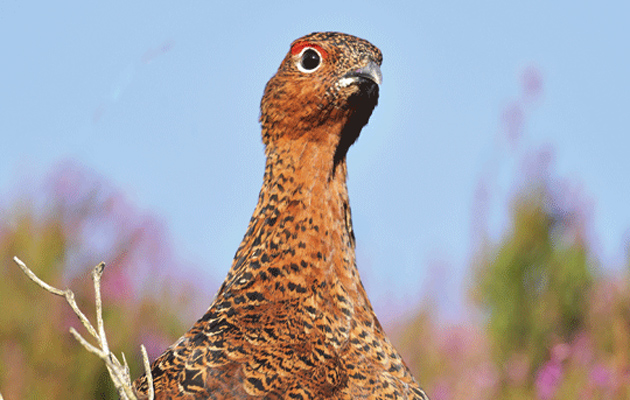Marks & Spencer grouse sales on hold
Marks & Spencer has announced that though it will not be stocking red grouse this season it is continuing to work with shooting and land managers to ensure sustainable supplies of game will be on its shelves in the future

Marks & Spencer has announced that it will not be stocking red grouse this season. The retailer told The Times that it will resume stocking the bird once it has received “independent confirmation” that its supplier estates comply with a code of practice it is developing with the RSPB and the Game & Wildlife Conservation Trust (GWCT). Moorland management groups have described the decision as a short-term setback, but have welcomed the code of practice in principle as a long-term opportunity to demonstrate the positve elements of grouse moor management to the public at large.
Marks & Spencer became the first UK supermarket to sell grouse when it stocked the birds last year in two of its flagship London stores — Marble Arch and High Street Kensington. Following the success of the trial, the retailer had planned to sell red grouse more widely across the UK.
This season, however, though it will be stocking its largest ever range of game, Marks & Spencer has taken the decision not to stock grouse as it feels it is not yet in a position to demonstrate that its sources are sustainable. The move follows social media and political lobbying campaigns led by those concerned about the alleged impact of driven grouse shooting on heather moorland and declining populations of birds of prey, particularly the hen harrier.
Final tweaks
Marks & Spencer head of agriculture Steve McLean confirmed that the code, which is still in draft form, includes provisions relating to sustainable moorland management, wildlife protection — including birds of prey — and limits on heather burning. Mr McLean said that after a few “tweaks” to deal with implementation issues, it would be published in its final form, saying: “It’s about making sure the code is truly practical. The worst thing you can have is a fantastic code of practice that isn’t implemented. My job is to make sure the team delivers a code that drives change, addresses the concerns of industry, customers and [conservation groups], and ensures we are selling a product that Marks & Spencer’s brand won’t be compromised by.”
Though James Robinson, RSPB’s head of nature policy, has called on the retailer to name the estates from which its grouse are sourced — believed to be located in the North of England and in the Scottish Borders — Marks & Spencer has declined to identify them to avoid possible repercussions from anti-game groups.
Silver lining
The news that there will be no Marks & Spencer grouse this year has been greeted with surprise and disappointment by shooting and countryside groups. In spite of this, those involved in moorland management have expressed confidence that most estates would have no trouble in establishing compliance with the code once it is published, and see such a public demonstration of sustainability as a silver lining.
Amanda Anderson, director of the Moorland Association (MA), told Shooting Times that, while the news of the delay was “hugely disappointing”, the MA would work with Marks & Spencer to ensure the code could be implemented swiftly and ensure it dovetailed with existing protected site regulations under which grouse moors operate, both at national and European levels. Ms Anderson said the accreditation process “will be an ideal opportunity to demonstrate to the public the positive environmental aspects of moorland management for grouse shooting, and indeed why the sites were designated in the first place. When rolling out a pilot of a new product it is perfectly normal to take the process to the next stage and ensure it meets all the industry standards. This is the first foray into the supermarket sector for our moorland estates and we need to get it right. If that needs another 12 months, then so be it.”
Tim Baynes, head of Scottish Land & Estates’ Moorland Group also commented that though the news would be a temporary blow for the estates and gamedealers involved, it ultimately offers a valuable opportunity to showcase the sustainability of well-managed grouse moors, saying: “It is disappointing that a social media campaign — with a vehement anti-grouse shooting agenda — has sought to bully a retailer and tarnish the reputation of the estates involved without evidence that they have done anything wrong. We do not know if any Scottish moors supply grouse to Marks & Spencer but would be confident that most would be able to comply with the practical verification system being developed by Marks & Spencer.”
Tim added: “Most Scottish grouse moors are managed to a very high standard in compliance with the muirburn code and wildlife protection laws, and some are now accredited under the Wildlife Estates Scotland initiative. We look forward to a long-term future of estates selling a premium product to M&S— and maybe other supermarkets — when their code of practice has been finalised.”
The GWCT’s head of advisory, Roger Draycott, said: “Marks & Spencer is hugely supportive of the game industry and have already embraced the selling of partridges, pheasants and other game in its stores. However, it has to ensure that its suppliers meet its strict codes of practice to ensure the sustainability of their products.
“The GWCT is currently working with Marks & Spencer to design a specific protocol that will be relevant to grouse moors and it is hoped that grouse will definitely be back on the menu next year.”
The Countryside Alliance, however, has described the move as “illogical and misjudged”. The alliance has written to Marks & Spencer expressing its dissatisfaction with a decision it feels was based on “pressure from anti-shooting activists” and will be advising its supporters of the best ways to raise their concerns.
To read Marks & Spencer’s blog on the issue, click here.








